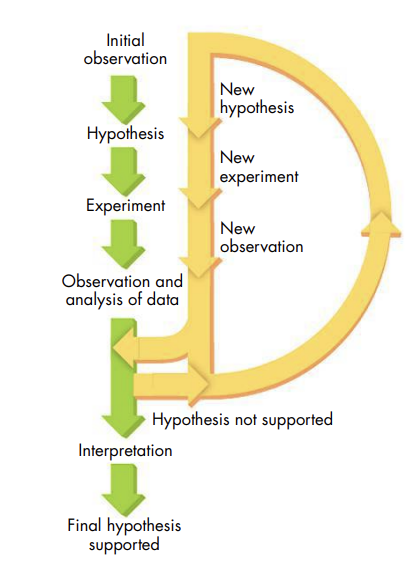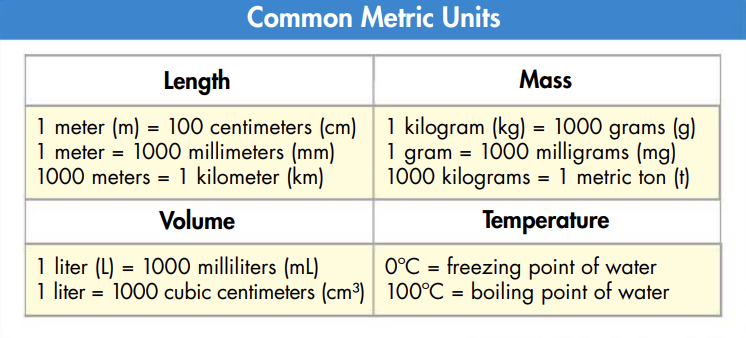Chapter 1: The Science of Biology
1.1 What is Science?
- Science: an organized way of gathering and analyzing evidence about the natural world
- Science is a process, not a “thing”
- The goals of science are to give explanations for natural events, understand patterns, and make predictions
The Parts of Scientific Methodology
Scientific studies begin with observation, the act of noticing and describing events or processes in a careful, orderly way
After asking questions, scientists use further observations to make inferences - ideas based on what is already known
- Inferences can lead to a hypothesis - a scientific explanation for a set of observations that can be tested
Testing a hypothesis often involves an experiment that keeps track of @@variables@@ - the things that can change (e.g., temperature, light, and time)
In a controlled experiment, only one variable is changed
The variable that changes is called the independent variable; the variable that is observed and that changes because of modifications to the independent variable is called the dependent variable
An experiment is usually divided into control and experimental groups
- A control group is treated the same as the experimental group except for one independent variable
Scientists make detailed records of experimental observations by gathering information called data
- Quantitative data are numbers found by counting or measuring
- Qualitative data describe things that cannot be counted
Scientists use data to support or refute the hypothesis, change the hypothesis, or draw a valid conclusion

1.2 Science in Context
Forming Ideas and Communicating Results
- Scientific attitudes include @@curiosity, skepticism, open-mindedness, and creativity@@
- Practical problems lead to questions, hypotheses, and experiments
- For example, people want cars that do not cause air pollution
- Discoveries lead to new technology and vice versa
- Publishing peer-reviewed papers in journals lets scientists share ideas and review each other’s work; sharing findings can lead to new questions
Scientific Theories
- In science, a theory is a well-tested explanation that unifies a broad range of observations and hypotheses and enables scientists to make accurate predictions about new situations
Science and Society
- Science does not include ethical or moral views
- Science can be affected by bias, a particular preference or point of view that is personal, rather than scientific
- Examples of biases include personal taste and liking one thing over another
- Using science involves understanding its limitations and how it fits into society
1.3 Studying Life
- Biology is the study of living things
- The Characteristics of Living Things:
- @@Living things are based on a universal genetic code@@
- All organisms store the information they need to live, grow, and reproduce in a genetic code written in a molecule called DNA
- @@Living things grow and develop@@
- During development, a single fertilized egg divides again and again
- As these cells divide, they differentiate and begin to look different from one another and do different jobs
- @@Living things respond to their environment@@
- A stimulus is a signal to which an organism responds
- Organisms notice and react to stimuli from their environment
- All forms of life on Earth are connected to a biosphere, the part of Earth in which life exists, including land, water, and air or atmosphere
- @@Living things reproduce@@
- Most plants and animals engage in sexual reproduction, in which cells from two parents come together to form the first cell of a new living thing
- Other living things reproduce through asexual reproduction, in which a single living thing makes offspring exactly the same as itself
- @@Living things maintain a stable internal environment, even when conditions outside of them change@@
- Homeostasis is the relatively constant internal physical and chemical conditions that organisms maintain
- @@Living things get and use material and energy to grow, develop, and reproduce@@
- Some living things, such as plants, get energy from sunlight and take up nutrients from air, water, and soil
- Other living things, including most animals, eat plants or other animals to get both nutrients and energy
- The chemical reactions through which an organism builds up or breaks down materials are called metabolism
- @@Living things are made up of one or more cells - the smallest units considered fully alive@@
- Cells can grow, respond to their surroundings, and reproduce
- @@Taken as a group, living things evolve, or change, over time@@
- Evolutionary change links all forms of life to a common origin of more than 3.5 billion years ago
- Evolution is the central organizing idea of all biology
Fields of Biology
- Global ecology explores how the world is affected by everything that living things do
- Biotechnology is a field based on the ability to read, write, and edit the genetic code
- Some biologists want to use computers to gather what is known about all organisms to put all living things into a single “Tree of All Life”
- Ecologists who study the evolution of diseases work to understand how viruses, bacteria, and other organisms evolve despite our efforts to fight them
- Scientists who work in genomics and molecular biology analyze data with powerful computers to learn about the growth, development, and history of life on Earth
Performing Biological Investigations
Scientific Measurement
- Most scientists use the metric system, a system of measurement in which units are based on multiples of 10
- A revised version of the metric system is called the International System of Units (SI)
